Feasibility Study and Impact of Daylight on Illumination Control for Energy-Saving Lighting Systems
Abstract
1. Introduction
2. Literature Review
3. Simulation
4. Experimental Setup and Results
5. Discussion
6. Conclusions
Author Contributions
Funding
Acknowledgments
Conflicts of Interest
References
- Energy Policy and Planning Office (EPPO), Ministry of Energy. Energy Statistics of Thailand 2017; EPPO: Bangkok, Thailand, 2017. [Google Scholar]
- Energy Policy and Planning Office (EPPO), Ministry of Energy. Energy Efficiency Plan 2015; EPPO: Bangkok, Thailand, 2015. [Google Scholar]
- Energy Policy and Planning Office (EPPO), Ministry of Energy. Thailand 20 Year Energy Efficiency Development Plan (EEDP); EPPO: Bangkok, Thailand, 2015. [Google Scholar]
- Lombard, C.; Mathews, E.H.; Kleingeld, M. Demand-Side Management through thermal efficiency in South African houses. Energy Build. 1999, 29, 229–239. [Google Scholar] [CrossRef]
- Lay, J.; Ondraczek, J.; Stoever, J. Renewables in the energy transition: Evidence on solar home systems and lighting fuel choice in Kenya. Energy Econ. 2013, 40, 350–359. [Google Scholar] [CrossRef]
- Chan, A.T.; Yeung, V.C.H. Implementing building energy codes in Hong Kong: Energy savings, environmental impacts and cost. Energy Build. 2005, 37, 631–642. [Google Scholar] [CrossRef]
- Li, Z.; Quan, S.J.; Yang, P.P.J. Energy performance simulation for planning a low carbon neighborhood urban district: A case study in the city of Macau. Habitat Int. 2016, 53, 206–214. [Google Scholar] [CrossRef]
- Krarti, M. Evaluation of large scale building energy efficiency retrofit program in Kuwait. Renew. Sustain. Energy Rev. 2015, 50, 1069–1080. [Google Scholar] [CrossRef]
- Sahoo, S.K.; Varma, P.; Lall, K.P.; Talwar, C.K. Energy efficiency in India: Achievements, challenges and legality. Energy Policy 2016, 88, 495–503. [Google Scholar] [CrossRef]
- Lopes, L.; Hokoi, S.; Miura, H.; Shuhei, K. Energy efficiency and energy savings in Japanese residential buildings—Research methodology and surveyed results. Energy Build. 2005, 37, 698–706. [Google Scholar] [CrossRef]
- Chandel, S.S.; Sharma, A.; Marwaha, B.M. Review of energy efficiency initiatives and regulations for residential buildings in India. Renew. Sustain. Energy Rev. 2016, 54, 1443–1458. [Google Scholar] [CrossRef]
- Jaber, S.; Ajib, S. Optimum, technical and energy efficiency design of residential building in Mediterranean region. Energy Build. 2011, 43, 1829–1834. [Google Scholar] [CrossRef]
- Ozturk, M.; Yuksel, Y.E. Energy structure of Turkey for sustainable development. Renew. Sustain. Energy Rev. 2016, 53, 1259–1272. [Google Scholar] [CrossRef]
- Mangan, S.D.; Oral, G.K. Assessment of residential building performances for the different climate zones of Turkey in terms of life cycle energy and cost efficiency. Energy Build. 2016, 110, 362–376. [Google Scholar] [CrossRef]
- Kusumadewi, T.V.; Limmeechokchai, B. Energy Efficiency Improvement and CO2 Mitigation in Residential Sector: Comparison between Indonesia and Thailand. Energy Procedia 2015, 79, 994–1000. [Google Scholar] [CrossRef]
- Huang, B.; Mauerhofer, V.; Geng, Y. Analysis of existing building energy saving policies in Japan and China. J. Clean. Prod. 2016, 112, 1510–1518. [Google Scholar] [CrossRef]
- Zhou, Z.; Zhang, S.; Wang, C.; Zuo, J.; He, Q.; Rameezdeen, R. Achieving energy efficient buildings via retrofitting of existing buildings: A case study. J. Clean. Prod. 2016, 112, 3605–3615. [Google Scholar] [CrossRef]
- Foran, T.; Pont, P.T.D.; Parinya, P.; Phumaraphand, N. Securing energy efficiency as a high priority: Scenarios for common appliance electricity consumption in Thailand. Energy Effic. 2010, 3, 347–364. [Google Scholar] [CrossRef]
- Gangolells, M.; Casals, M.; Forcada, N.; Macarulla, M.; Cuerva, E. Energy mapping of existing building stock in Spain. J. Clean. Prod. 2016, 112, 3895–3904. [Google Scholar] [CrossRef]
- Marshall, E.; Steinberger, J.K.; Dupont, V.J.; Foxon, T.J. Combining energy efficiency measure approaches and occupancy patterns in building modelling in the UK residential context. Energy Build. 2016, 111, 98–108. [Google Scholar] [CrossRef]
- Tiangket, A.; Chullabodhi, B.; Pas, K.E.O.; Watechagit, S. The Energy Saving Calculation for a Residential Sector in Thailand with Top-Down Methodology. Energy Procedia 2015, 79, 415–422. [Google Scholar] [CrossRef]
- Gago, E.J.; Garcia, J.O.; Estrella, A.E. Development of an energy model for the residential sector: Electricity consumption in Andalusia, Spain. Energy Build. 2011, 43, 1315–1321. [Google Scholar] [CrossRef]
- Zhang, T.; Siebers, P.O.; Aickelin, U. Modelling electricity consumption in office buildings: An agent based approach. Energy Build. 2011, 43, 2882–2892. [Google Scholar] [CrossRef]
- Taniguchi, A.; Inoue, T.; Otsuki, M.; Yamaguchi, Y.; Shimoda, Y.; Takami, A.; Hanaoka, K. Estimation of the contribution of the residential sector to summer peak demand reduction in Japan using an energy end-use simulation model. Energy Build. 2016, 112, 80–92. [Google Scholar] [CrossRef]
- Kialashaki, A.; Reisel, J.R. Modeling of the energy demand of the residential sector in the United States using regression models and artificial neural networks. Appl. Energy 2013, 108, 271–280. [Google Scholar] [CrossRef]
- Wang, L.; Mathew, P.; Pang, X. Uncertainties in energy consumption introduced by building operations and weather for a medium-size office building. Energy Build. 2012, 53, 152–158. [Google Scholar] [CrossRef]
- Rezaie, B.; Esmailzadeh, E.; Dincer, I. Renewable energy options for buildings: Case studies. Energy Build. 2011, 43, 56–65. [Google Scholar] [CrossRef]
- Kumar, P.S.; Biswas, S.; Kumari, S. Building integrated photovoltaic generation system. In Proceedings of the 2014 1st International Conference on Non Conventional Energy (ICONCE), Kalyani, India, 16–17 January 2014; pp. 80–83. [Google Scholar]
- Hongxing, Y.; Yuyan, F. Building-integrated photovoltaic application—Its practice in Hong Kong. In Proceedings of the 3rd World Conference on Photovoltaic Energy Conversion, Osaka, Japan, 11–17 May 2003; pp. 2490–2493. [Google Scholar]
- Fathabadi, H. Increasing energy efficiency of PV-converter-battery section of standalone building integrated photovoltaic systems. Energy Build. 2015, 101, 1–11. [Google Scholar] [CrossRef]
- Zhang, W.; Liu, S.; Li, N.; Xie, H.; Li, X. Development forecast and technology roadmap analysis of renewable energy in buildings in China. Renew. Sustain. Energy Rev. 2015, 49, 395–402. [Google Scholar] [CrossRef]
- Escriva, G.E. Basic actions to improve energy efficiency in commercial buildings in operation. Energy Build. 2011, 43, 3106–3111. [Google Scholar] [CrossRef]
- Danny Harvey, L.D. Reducing energy use in the building sector: Measures, costs, and examples. Energy Effic. 2009, 2, 139–163. [Google Scholar] [CrossRef]
- Tan, B.; Yavuz, Y.; Otay, E.N.; Çamlıbel, E. Optimal selection of energy efficiency measures for energy sustainability of existing buildings. Comput. Oper. Res. 2016, 66, 258–271. [Google Scholar] [CrossRef]
- Lee, D.; Cheng, C.C. Energy savings by energy management systems: A review. Renew. Sustain. Energy Rev. 2016, 56, 760–777. [Google Scholar] [CrossRef]
- Nisiforou, O.A.; Poullis, S.; Charalambides, A.G. Behaviour, attitudes and opinion of large enterprise employees with regard to their energy usage habits and adoption of energy saving measures. Energy Build. 2012, 55, 299–311. [Google Scholar] [CrossRef]
- Sasidharan, N.; Madhu, M.N.; Singh, J.G.; Ongsakul, W. An approach for an efficient hybrid AC/DC solar powered Homegrid system based on the load characteristics of home appliances. Energy Build. 2015, 108, 23–35. [Google Scholar] [CrossRef]
- Prasartkaew, B.; Kumar, S. Design of a renewable energy based air-conditioning system. Energy Build. 2014, 68, 156–164. [Google Scholar] [CrossRef]
- Bukoski, J.; Gheewala, S.H.; Mui, A.; Smead, M.; Chirarattananon, S. The life cycle assessment of a solar-assisted absorption chilling system in Bangkok, Thailand. Energy Build. 2014, 72, 150–156. [Google Scholar] [CrossRef]
- Promjiraprawat, K.; Winyuchakrit, P.; Limmeechokchai, B.; Masui, T.; Hanaoka, T.; Matsuoka, Y. CO2 mitigation potential and marginal abatement costs in Thai residential and building sectors. Energy Build. 2014, 80, 631–639. [Google Scholar] [CrossRef]
- Ryckaert, W.R.; Lootens, C.; Geldof, J.; Hanselaer, P. Criteria for energy efficient lighting in buildings. Energy Build. 2010, 42, 341–347. [Google Scholar] [CrossRef]
- Garcia, E.J.P.; Chen, A.; Santiago, I.; Outeiriño, F.J.B.; Arias, J.M.F.; Munoz, A.M. Stochastic model for lighting’s electricity consumption in the residential sector. Impact of energy saving actions. Energy Build. 2015, 89, 245–259. [Google Scholar] [CrossRef]
- Yang, H.; Lee, Y. Lighting Scheduling for Energy Saving in Smart House Based on Life Log Data. Procedia Environ. Sci. 2014, 22, 403–413. [Google Scholar] [CrossRef]
- Yun, G.Y.; Kim, H.; Kim, J.T. Effects of occupancy and lighting use patterns on lighting energy consumption. Energy Build. 2012, 46, 152–158. [Google Scholar] [CrossRef]
- Zhou, X.; Yan, D.; Hong, T.; Ren, X. Data analysis and stochastic modeling of lighting energy use in large office buildings in China. Energy Build. 2015, 86, 275–287. [Google Scholar] [CrossRef]
- Preston, D.J.; Woodbury, K.A. Cost-benefit analysis of retrofit of high-intensity discharge factor lighting with energy-saving alternatives. Energy Effic. 2013, 6, 255–269. [Google Scholar] [CrossRef]
- Lam, J.C.W.; Hui, J.C.Y.; Jain, P.K. A Dimmable High Power Factor Single-Switch Electronic Ballast for Compact Fluorescent Lamps With Incandescent Phase-Cut Dimmers. IEEE Trans. Ind. Electron. 2012, 59, 1879–1888. [Google Scholar] [CrossRef]
- Chiradeja, P.; Ngaopitakkul, A.; Jettanasen, C. Energy savings analysis and harmonics reduction for the electronic ballast of T5 fluorescent lamp in a building’s lighting system. Energy Build. 2015, 97, 107–117. [Google Scholar] [CrossRef]
- Wang, S.C.; Chen, Y.L.; Lin, H.B.; Shen, K.Y.; Huang, K.C. Realization of a High-Efficiency T5 Ballast with Multi-dimming Mechanisms Based on Lamp Arc Modeling. In Proceedings of the 8th IEEE Conference on Industrial Electronics and Applications (ICIEA), Melbourne, Australia, 19–21 June 2013; pp. 1077–1082. [Google Scholar]
- Principi, P.; Fioretti, R. A comparative life cycle assessment of luminaires for general lighting for the office—Compact fluorescent (CFL) vs Light Emitting Diode (LED)—A case study. J. Clean. Prod. 2014, 83, 96–107. [Google Scholar] [CrossRef]
- Ahn, B.L.; Jang, C.Y.; Leigh, S.B.; Yoo, S.; Jeong, H. Effect of LED lighting on the cooling and heating loads in office buildings. Appl. Energy 2014, 113, 1484–1489. [Google Scholar] [CrossRef]
- Tetri, E.; Sarvaranta, A.; Syri, S. Potential of new lighting technologies in reducing household lighting energy use and CO2 emissions in Finland. Energy Effic. 2014, 7, 559–570. [Google Scholar] [CrossRef]
- Carrillo, C.; Dorado, E.D.; Cidras, J.; Pregal, A.B.; Falcon, P.; Fernandez, A.; Sanchez, A.A. Lighting control system based on digital camera for energy saving in shop windows. Energy Build. 2013, 59, 143–151. [Google Scholar] [CrossRef]
- Soori, P.K.; Vishwas, M. Lighting control strategy for energy efficient office lighting system design. Energy Build. 2013, 66, 329–337. [Google Scholar] [CrossRef]
- Wang, Y.; Dasgupta, P. Designing an adaptive lighting control system for smart buildings and homes. In Proceedings of the IEEE 12th International Conference on Networking, Sensing and Control (ICNSC), Taipei, Taiwan, 9–11 April 2015; pp. 450–455. [Google Scholar]
- Yin, C.; Stark, B.; Chen, Y.Q.; Zhong, S.M.; Lau, E. Fractional-order adaptive minimum energy cognitive lighting control strategy for the hybrid lighting system. Energy Build. 2015, 87, 176–184. [Google Scholar] [CrossRef]
- Manganelli, M.; Consalvi, R. Design and energy performance assessment of high-efficiency lighting systems. In Proceedings of the IEEE 15th International Conference on Environment and Electrical Engineering (EEEIC), Rome, Italy, 10–13 June 2015; pp. 1035–1040. [Google Scholar]
- Yi, Y.K. Adaptation of Kriging in daylight modeling for energy simulation. Energy Build. 2016, 111, 479–496. [Google Scholar] [CrossRef]
- Tsuei, C.H.; Sun, W.S. Simulating the Illuminance and Efficiency of Sunlight/LED Hybrid Illuminating System Used in Indoor Lighting Design. In Proceedings of the 2009 Symposium on Photonics and Optoelectronics, Wuhan, China, 14–16 August 2009; pp. 1–4. [Google Scholar]
- Mayhoub, M.; Carter, D. A feasibility study for hybrid lighting systems. Energy Build. 2012, 53, 83–94. [Google Scholar] [CrossRef]
- Fasi, M.A.; Budaiwi, I.M. Energy performance of windows in office buildings considering daylight integration and visual comfort in hot climates. Energy Build. 2015, 108, 307–316. [Google Scholar] [CrossRef]
- Gentile, N.; Dubois, M.C.T.; Laike, T. Daylight harvesting control systems design recommendations based on a literature review. In Proceedings of the IEEE 15th International Conference on Environment and Electrical Engineering (EEEIC), Rome, Italy, 10–13 June 2015; pp. 632–637. [Google Scholar]
- Parise, L.; Lamonaca, F.; Carnì, D.L. Interior lighting control system: A practical case using daylight harvesting control strategy. In Proceedings of the 2015 IEEE 15th International Conference on Environment and Electrical Engineering (EEEIC), Rome, Italy, 10–13 June 2015; pp. 719–724. [Google Scholar]
- Verso, V.R.M.L.; Invernizzi, S.; Carlin, A.; Polato, A. Towards the factory of the future: A new concept based on optimized daylighting for comfort and energy saving. In Proceedings of the 2015 IEEE 15th International Conference on Environment and Electrical Engineering (EEEIC), Rome, Italy, 10–13 June 2015; pp. 701–706. [Google Scholar]
- Kumar, R. New algorithms for daylight harvesting in a private office. In Proceedings of the 2015 18th International Conference on Information Fusion (Fusion), Washington, DC, USA, 6–9 July 2015; pp. 383–392. [Google Scholar]
- Hansen, V.G.; Edmonds, I. Methods for the illumination of multilevel buildings with vertical light pipes. Sol. Energy 2015, 117, 74–88. [Google Scholar] [CrossRef]
- Seo, D.; Park, L.; Ihm, P.; Krarti, M. Optimal electrical circuiting layout and desk location for daylighting controlled spaces. Energy Build. 2012, 51, 122–130. [Google Scholar] [CrossRef]
- Caicedo, D.; Pandharipande, A. Sensor-Driven Lighting Control with Illumination and Dimming Constraints. IEEE Sens. J. 2015, 15, 5169–5176. [Google Scholar] [CrossRef]
- Fonseca, R.W.D.; Didone, E.L.; Pereira, F.O.R. Using artificial neural networks to predict the impact of daylighting on building final electric energy requirements. Energy Build. 2013, 61, 31–38. [Google Scholar] [CrossRef]
- Gorgulu, S.; Ekren, N. Energy saving in lighting system with fuzzy logic controller which uses light-pipe and dimmable ballast. Energy Build. 2013, 61, 172–176. [Google Scholar] [CrossRef]
- Bellia, L.; Fragliasso, F.; Pedace, A. Evaluation of Daylight Availability for Energy Savings. J. Daylighting 2015, 2, 12–20. [Google Scholar] [CrossRef]
- Parise, G.; Martirano, L. Daylight Impact on Energy Performance of Internal Lighting. IEEE Trans. Ind. Appl. 2013, 49, 242–249. [Google Scholar] [CrossRef]
- Li, D.H.W. A review of daylight illuminance determinations and energy implications. Appl. Energy 2010, 87, 2109–2118. [Google Scholar] [CrossRef]
- Kyle, K.; Lee, E.S. Measured daylighting potential of a static optical louver system under real sun and sky conditions. Build. Environ. 2015, 92, 347–359. [Google Scholar]
- Acosta, I.; Munoz, C.; Campano, M.A.; Navarro, J. Analysis of daylight factors and energy saving allowed by windows under overcast sky conditions. Renew. Energy 2015, 77, 194–207. [Google Scholar] [CrossRef]
- Sudan, M.; Tiwari, G.N.; Helal, I.M.A. A daylight factor model under clear sky conditions for building: An experimental validation. Sol. Energy 2015, 115, 379–389. [Google Scholar] [CrossRef]
- Bellia, L.; Pedace, A.; Fragliasso, F. Dynamic daylight simulations: Impact of weather file’s choice. Sol. Energy 2015, 117, 224–235. [Google Scholar] [CrossRef]
- Edwards, L.; Torcellini, P. A Literature Review of the Effects of Natural Light on Building Occupants; National Renewable Energy Laboratory: Golden, CO, USA, 2002.
- Konis, K.S. Effective Daylighting: Evaluating Daylighting Performance in the San Francisco Federal Building from the Perspective of Building Occupants. Ph.D. Thesis, University of California, Berkeley, CA, USA, 2011. [Google Scholar]
- Comité Européen de Normalisation (CEN). EN 12464-1: Light and Lighting—Lighting of Work Places, Part 1: Indoor Work Places; CEN: Brussels, Belgium, 2002. [Google Scholar]
- International Commission on Illumination (CIE). CIE S 008/E: 2001: Lighting of Work Places—Part 1: Indoor; CIE: Vienna, Austria, 2001. [Google Scholar]

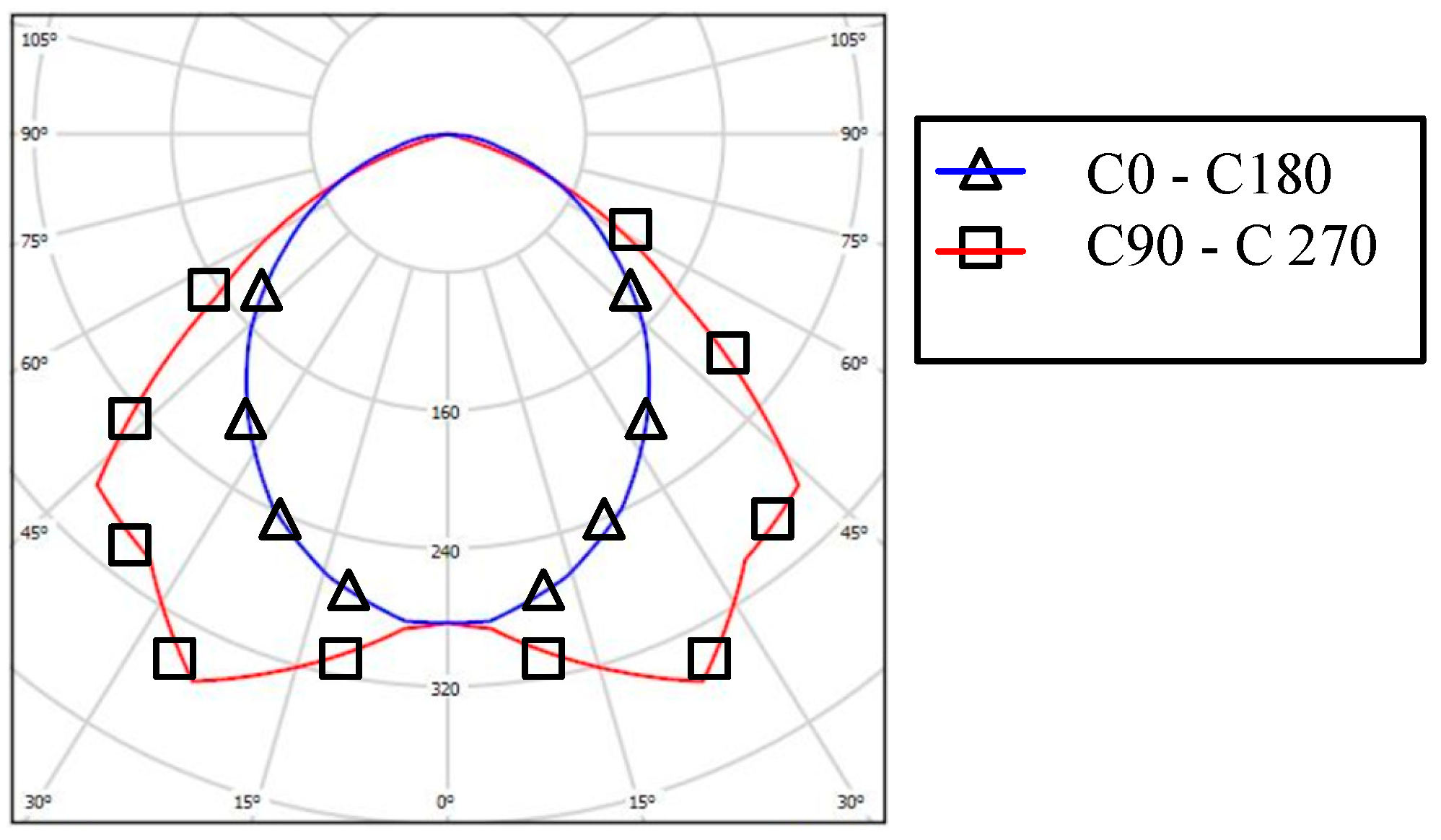
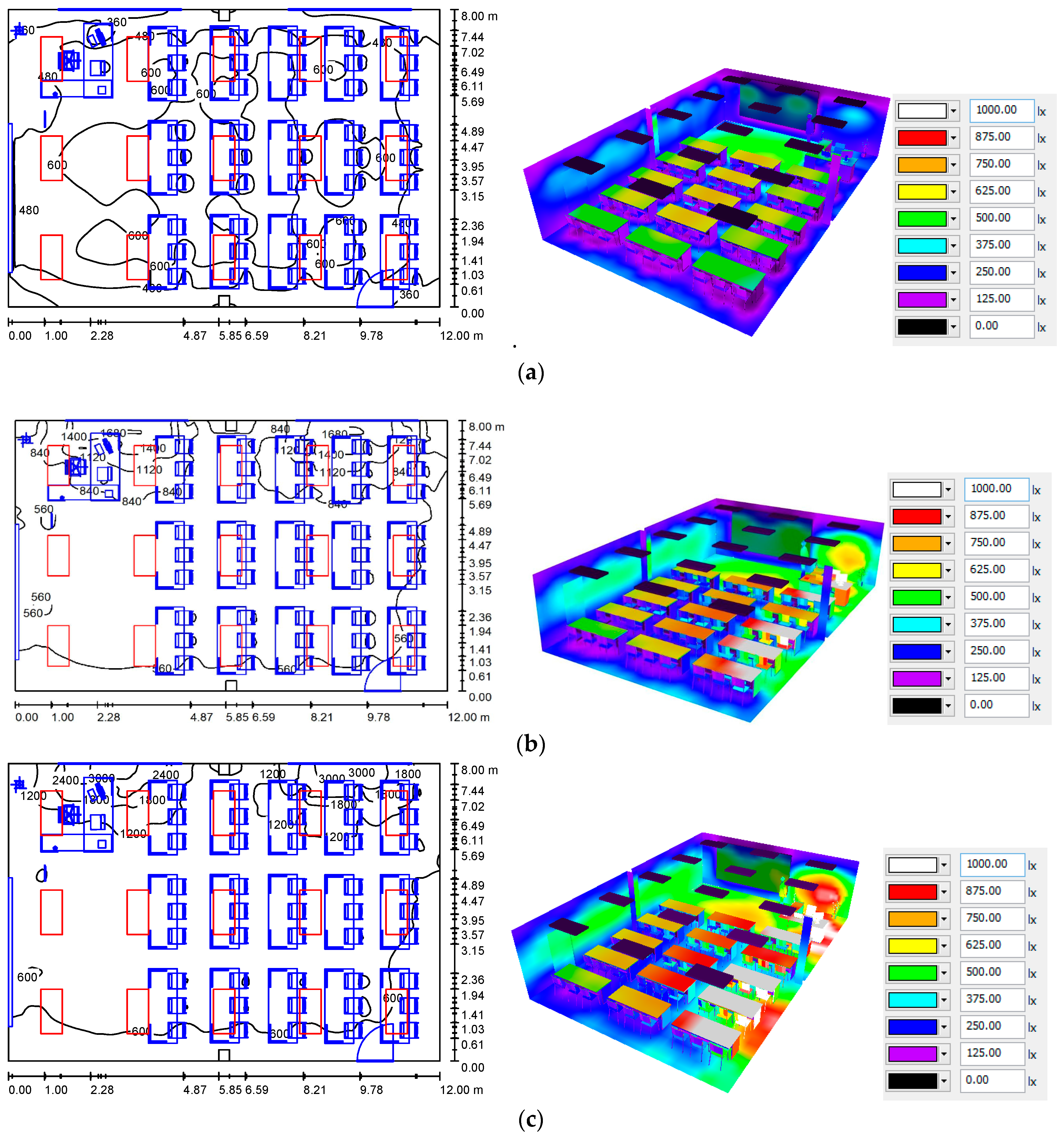
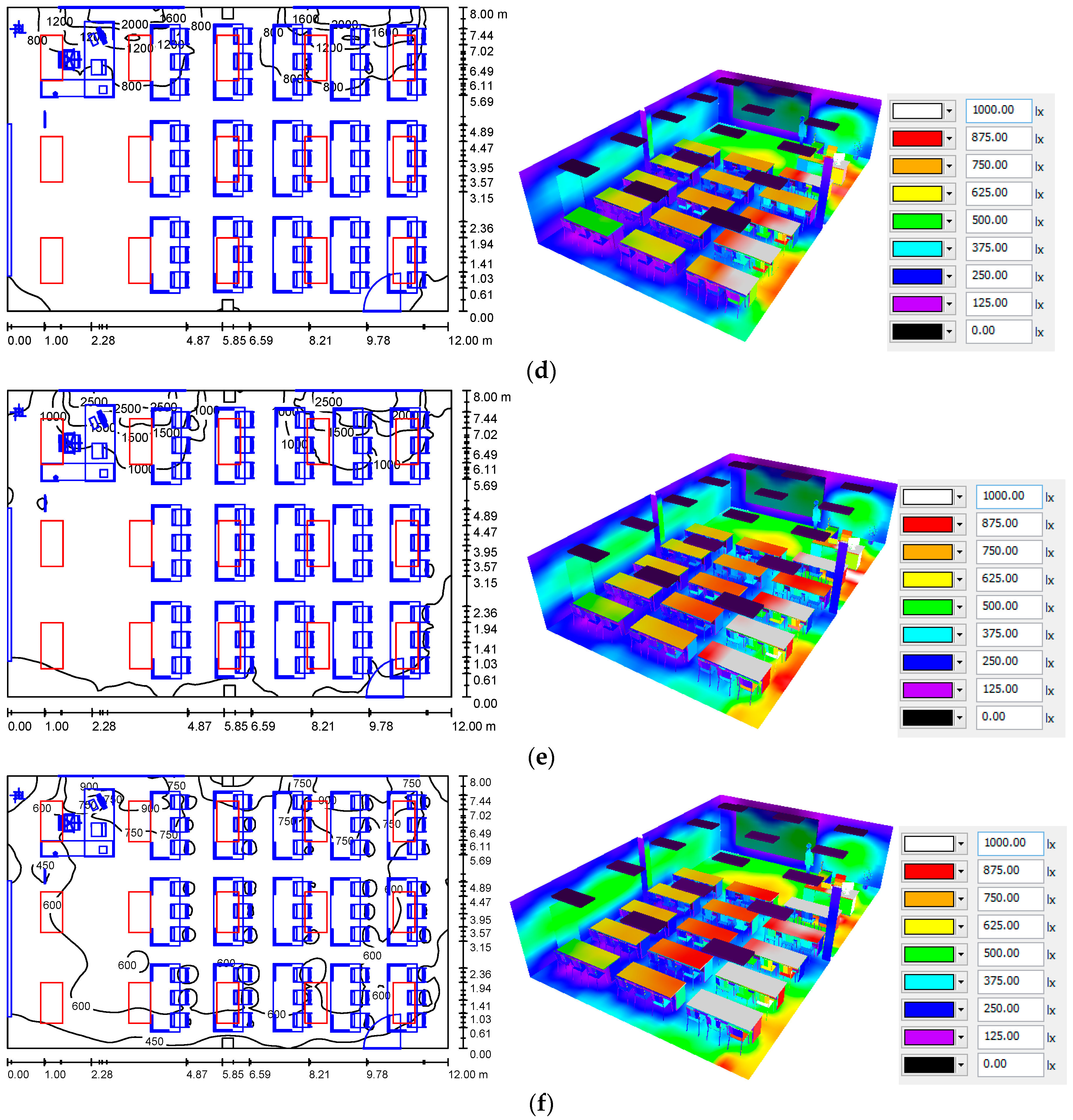
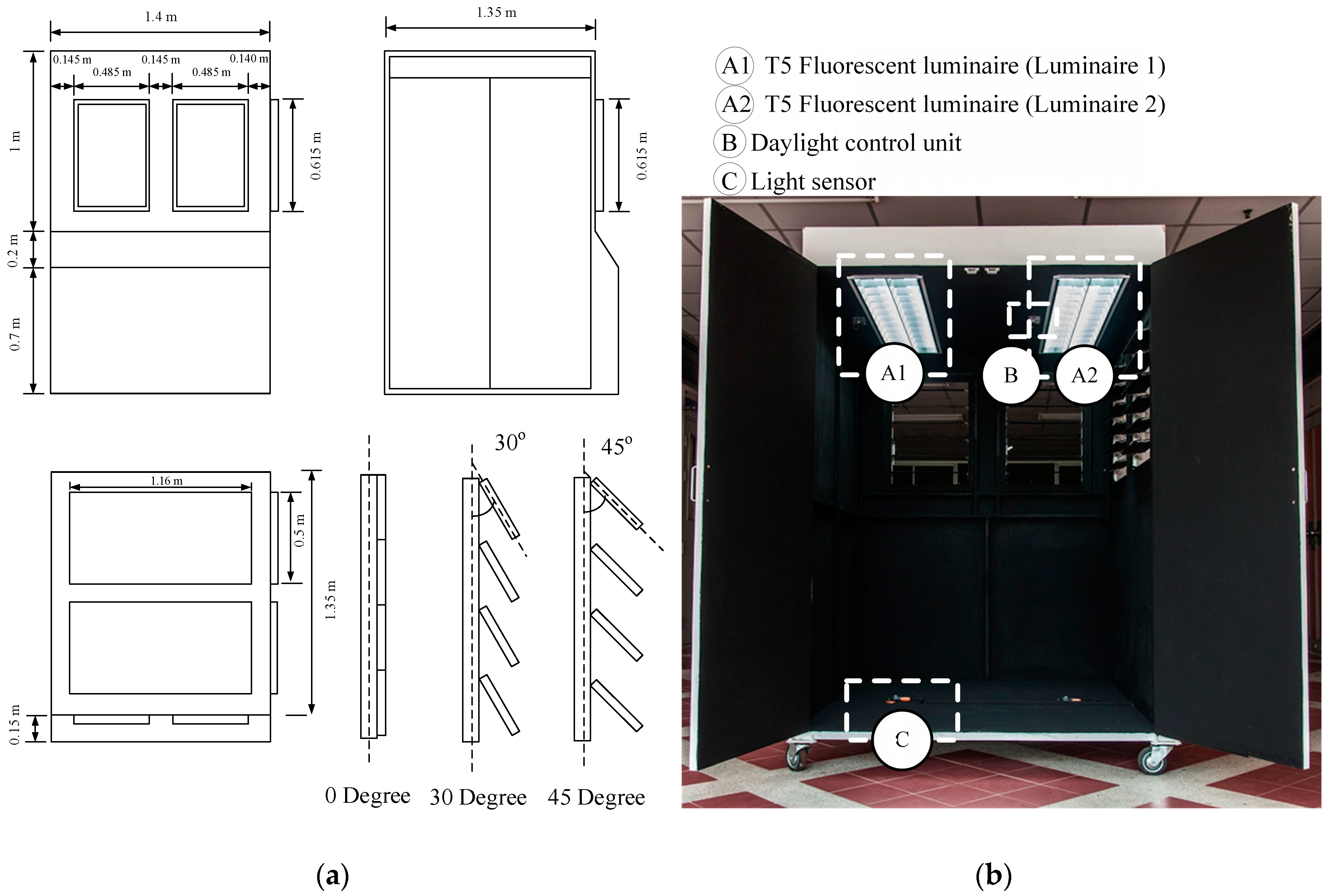
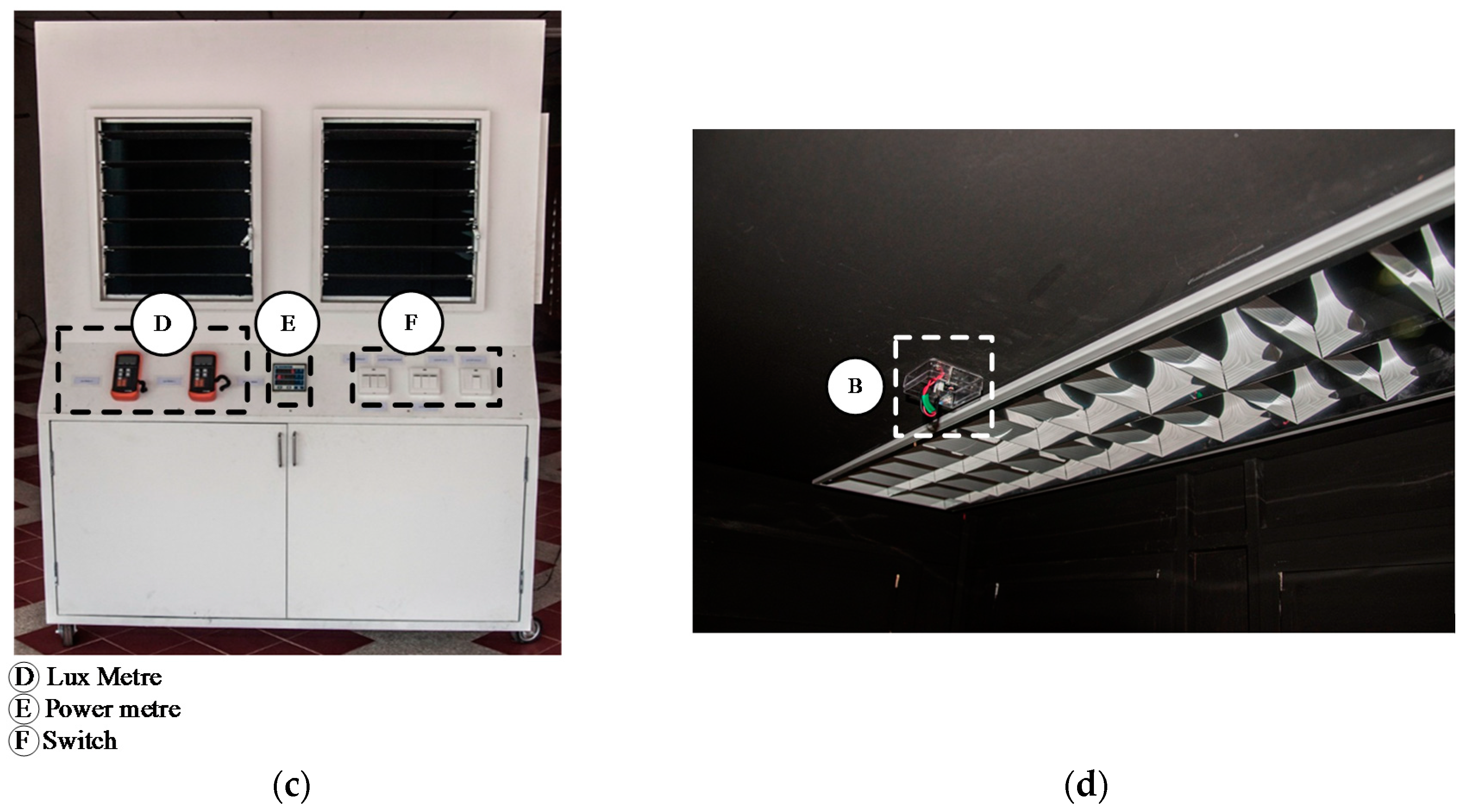
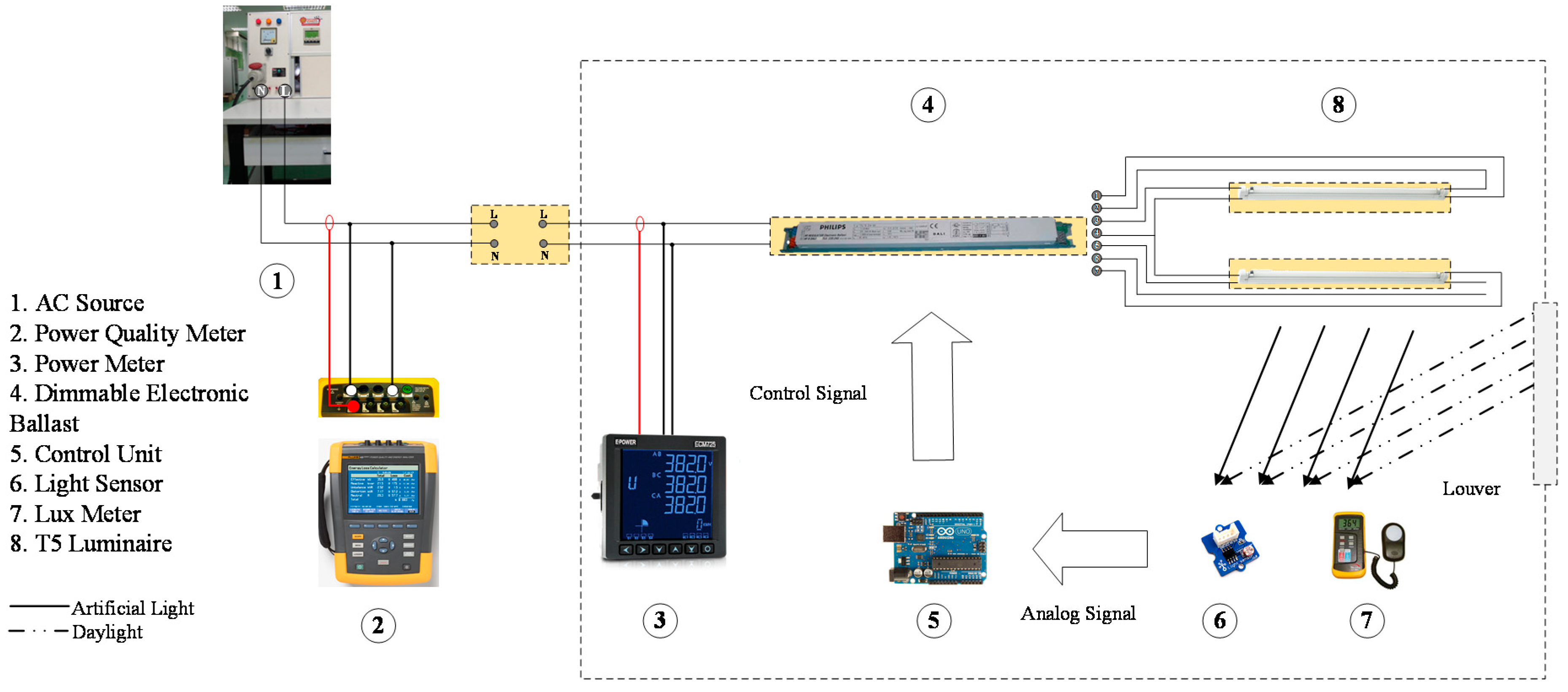
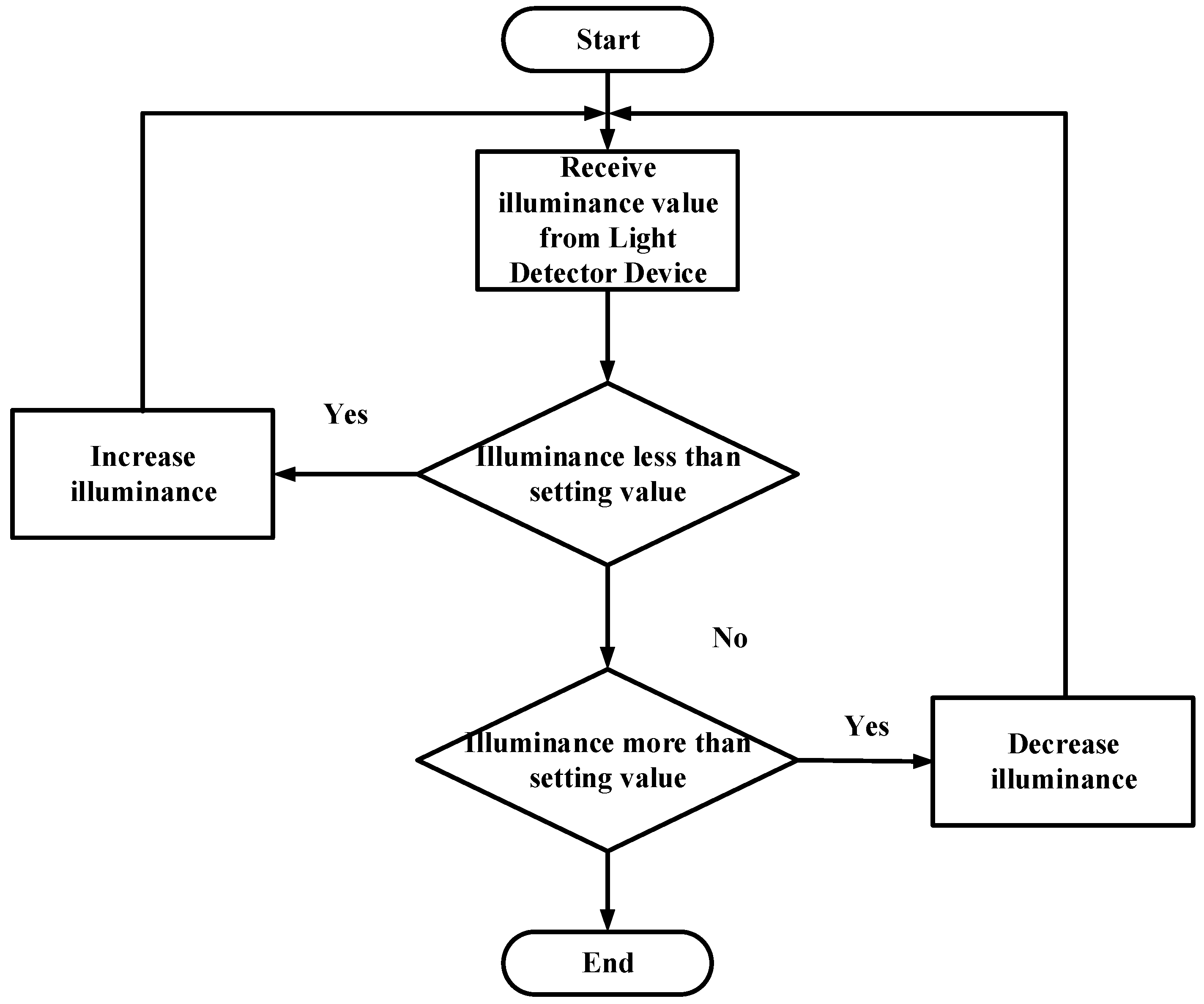
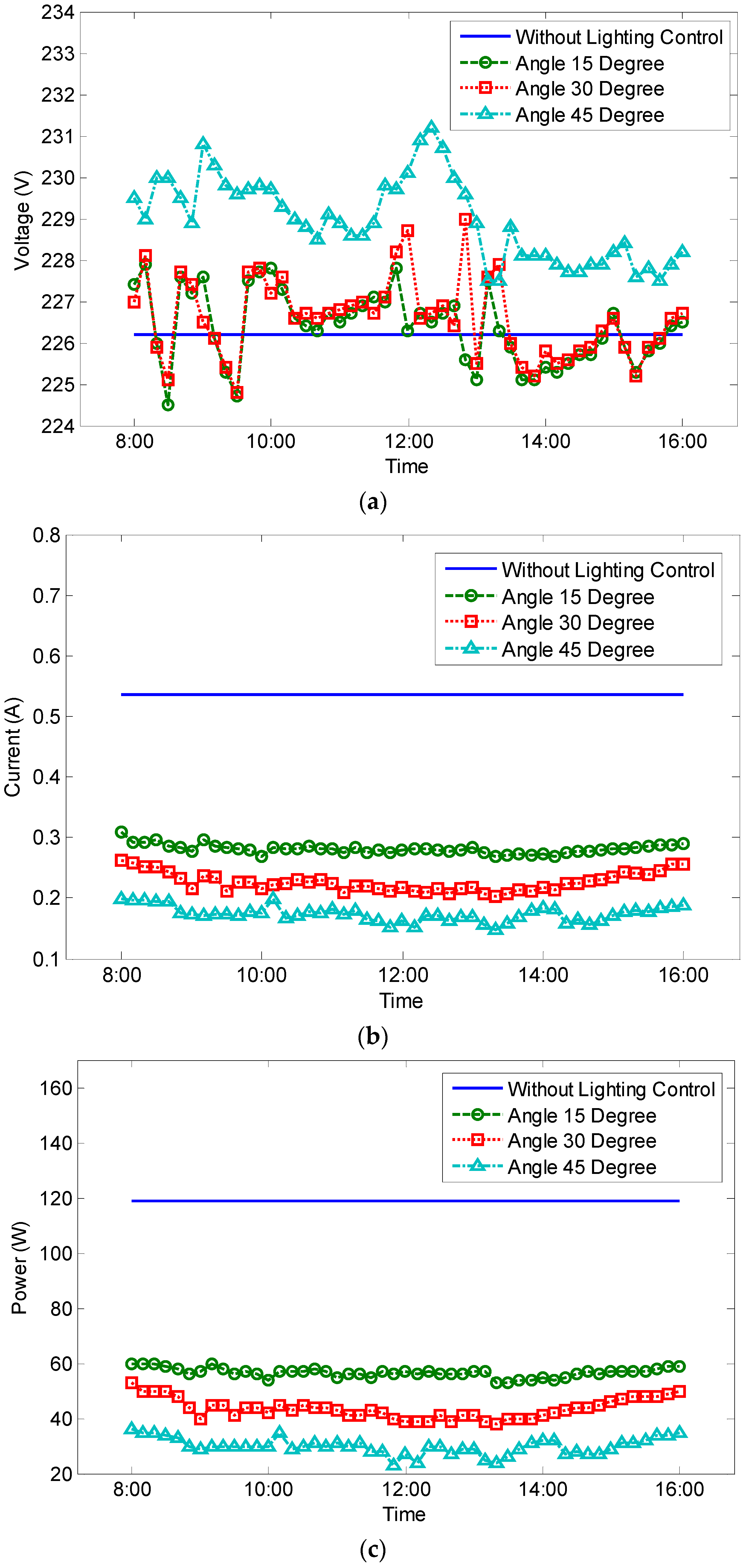
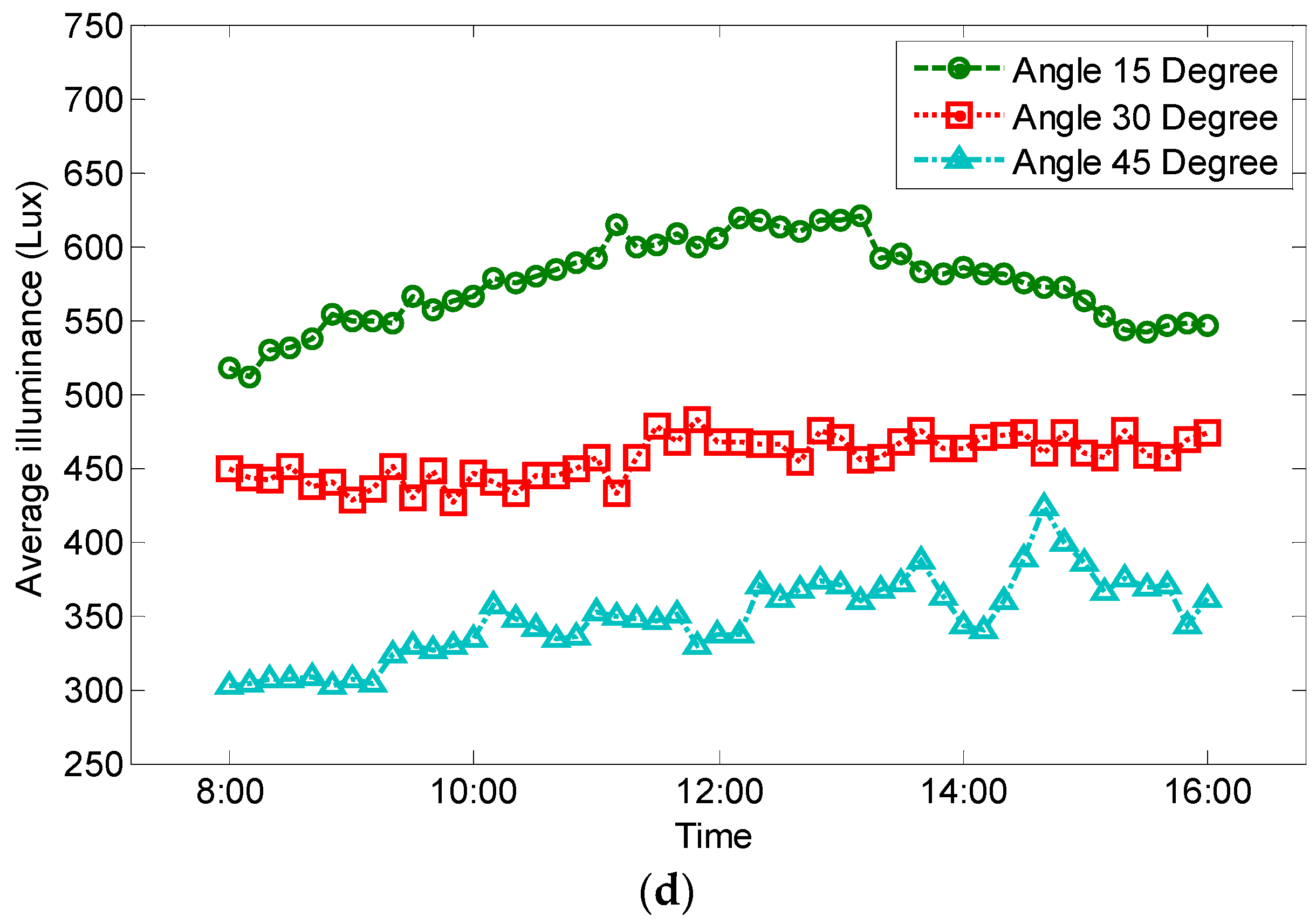
| Year | Residential (GWh) | Small General Service (GWh) | Business (GWh) | Industrial (GWh) | Government and Non-Profit (GWh) | Agriculture (GWh) | Other (GWh) | Total (GWh) | Free of Charge (GWh) | Grand Total (GWh) |
|---|---|---|---|---|---|---|---|---|---|---|
| 2015 | 41,286 | 42,466 | 83,984 | 179 | 387 | 3789 | 172,090 | 2743 | 174,833 | 41,286 |
| 2016 | 43,932 | 44,639 | 86,878 | 201 | 267 | 3967 | 179,885 | 2963 | 182,847 | 43,932 |
| 2017 | 44,374 | 45,100 | 87,772 | 198 | 298 | 4247 | 181,989 | 3135 | 185,124 | 44,374 |
| Growth Rate (%) | ||||||||||
| 2016 | 6.41 | 5.12 | 3.45 | 12.40 | −30.87 | 4.70 | 4.53 | 7.99 | 4.58 | 6.41 |
| 2017 | 1.01 | 1.03 | 1.03 | −1.66 | 11.56 | 7.07 | 1.17 | 5.81 | 1.25 | 1.01 |
| Type of Luminaire | Luminous Flux (Lumen per Luminaires) | Total Luminous Flux (Lumen) | Luminaire Wattage (Watt per Luminaires) | Total Wattage (Watt) |
|---|---|---|---|---|
| Fluorescent T5 | 4516 | 67,737 | 56 | 840 |
| Time | Surface | Reflectance Coefficient (%) | Average Illuminance (lux) | Minimum Illuminance (lux) | Maximum Illuminance (lux) | Uniformity of Illuminance | Energy Consumption Index (Watt per Square Meter) |
|---|---|---|---|---|---|---|---|
| Without Daylight | Workplane | - | 536 | 136 | 694 | 0.253 | 8.75 |
| Floor | 20 | 273 | 42 | 595 | 0.155 | ||
| Ceiling | 70 | 138 | 48 | 189 | 0.347 | ||
| Walls | 52 | 215 | 17 | 432 | - | ||
| 8 a.m. | Workplane | - | 739 | 339 | 1736 | 0.458 | 8.75 |
| Floor | 20 | 361 | 83 | 780 | 0.230 | ||
| Ceiling | 70 | 186 | 70 | 267 | 0.377 | ||
| Walls | 52 | 290 | 26 | 738 | - | ||
| 10 a.m. | Workplane | - | 901 | 369 | 3171 | 0.409 | 8.75 |
| Floor | 20 | 440 | 98 | 1362 | 0.223 | ||
| Ceiling | 70 | 222 | 89 | 351 | 0.403 | ||
| Walls | 52 | 340 | 36 | 1023 | - | ||
| 12 a.m. | Workplane | - | 724 | 335 | 2236 | 0.463 | 8.75 |
| Floor | 20 | 367 | 95 | 1096 | 0.258 | ||
| Ceiling | 70 | 179 | 71 | 254 | 0.399 | ||
| Walls | 52 | 271 | 29 | 596 | - | ||
| 2 p.m. | Workplane | - | 822 | 348 | 2787 | 0.424 | 8.75 |
| Floor | 20 | 402 | 106 | 1235 | 0.263 | ||
| Ceiling | 70 | 203 | 79 | 316 | 0.388 | ||
| Walls | 52 | 312 | 35 | 1000 | - | ||
| 4 p.m. | Workplane | - | 615 | 309 | 1031 | 0.503 | 8.75 |
| Floor | 20 | 309 | 66 | 624 | 0.214 | ||
| Ceiling | 70 | 156 | 49 | 215 | 0.318 | ||
| Walls | 52 | 239 | 14 | 501 | - |
| Angle (Degree) | Before Installation of Daylight Control (without Lighting Control) | |||||
| Voltage (V) | Current (A) | Real Power (W) | Illuminance (Lux) | |||
| Luminaire 1 | Luminaire 2 | Average | ||||
| 0° | 226.1 | 0.576 | 118 | 1082 | 1026 | 1054.0 |
| 15° | 226.2 | 0.535 | 119 | 1107 | 1103 | 1105.0 |
| 30° | 226.5 | 0.538 | 120 | 1106 | 1109 | 1107.5 |
| 45° | 226.3 | 0.537 | 119 | 1132 | 1128 | 1130.0 |
| Angle (Degree) | After Installation of Daylight Control (with Lighting Control) | |||||
| Voltage (V) | Current (A) | Real Power (W) | Illuminance (Lux) | |||
| Luminaire 1 | Luminaire 2 | Average | ||||
| 0° | 226.8 | 0.306 | 62 | 365 | 455 | 410.0 |
| 15° | 226.9 | 0.297 | 60 | 335 | 460 | 397.5 |
| 30° | 226.8 | 0.289 | 59 | 380 | 448 | 414.0 |
| 45° | 226.6 | 0.265 | 53 | 394 | 414 | 404.0 |
| Angle (Degree) | Before Installation of Daylight Control (without Lighting Control) | |||||
| Voltage (V) | Current (A) | Real Power (W) | Illuminance (Lux) | |||
| Luminaire 1 | Luminaire 2 | Average | ||||
| 0° | 224.1 | 0.548 | 119 | 1141 | 1091 | 1116 |
| 15° | 223.1 | 0.536 | 119 | 1310 | 1186 | 1248 |
| 30° | 224 | 0.532 | 117 | 1110 | 1428 | 1269 |
| 45° | 223.9 | 0.538 | 118 | 1085 | 1558 | 1321.5 |
| Angle (Degree) | After Installation of Daylight Control (with Lighting Control) | |||||
| Voltage (V) | Current (A) | Real Power (W) | Illuminance (Lux) | |||
| Luminaire 1 | Luminaire 2 | Average | ||||
| 0° | 224.2 | 0.281 | 57 | 462 | 440 | 451 |
| 15° | 223.8 | 0.246 | 48 | 590 | 477 | 533.5 |
| 30° | 224 | 0.193 | 35 | 209 | 610 | 409.5 |
| 45° | 224 | 0.147 | 22 | 60 | 590 | 325 |
© 2018 by the authors. Licensee MDPI, Basel, Switzerland. This article is an open access article distributed under the terms and conditions of the Creative Commons Attribution (CC BY) license (http://creativecommons.org/licenses/by/4.0/).
Share and Cite
Bunjongjit, S.; Ngaopitakkul, A. Feasibility Study and Impact of Daylight on Illumination Control for Energy-Saving Lighting Systems. Sustainability 2018, 10, 4075. https://doi.org/10.3390/su10114075
Bunjongjit S, Ngaopitakkul A. Feasibility Study and Impact of Daylight on Illumination Control for Energy-Saving Lighting Systems. Sustainability. 2018; 10(11):4075. https://doi.org/10.3390/su10114075
Chicago/Turabian StyleBunjongjit, Sulee, and Atthapol Ngaopitakkul. 2018. "Feasibility Study and Impact of Daylight on Illumination Control for Energy-Saving Lighting Systems" Sustainability 10, no. 11: 4075. https://doi.org/10.3390/su10114075
APA StyleBunjongjit, S., & Ngaopitakkul, A. (2018). Feasibility Study and Impact of Daylight on Illumination Control for Energy-Saving Lighting Systems. Sustainability, 10(11), 4075. https://doi.org/10.3390/su10114075




